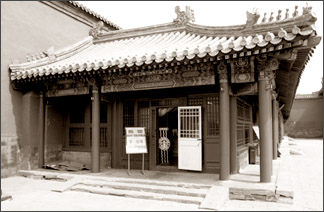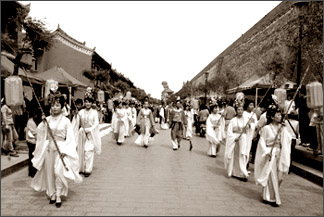... of contrasts and colourful images
|

Forbidden City
|
Disembarking at Beijing's Capital international Airport is to be
immediately thrust into an exciting other world. Instantly, the earthy
flavour of green tea, the nasal glissandi of the Er Hu and the nostalgic
rhythms of Chinese classical music combine with the tangy broth of
Chinese noodles and the dark mesmerizing eyes of the East, leaving
visitors not just a little stunned.
A world that today also combines the sites and sounds of ancient
heritage with contemporary global architecture and modernization,
Beijing is a place of immense curiosity that satisfies all tastes.
Walking Tour
Tempted by the rare rather than the usual, many global travellers to
Beijing overlook what the guidebooks eagerly suggest, and this can be a
mistake, the rare can lie just at the borders of the usual.
Yandai Xie Jie (Tobacco Pipe Lane) and Liulichang Market are two
places that attract great bands of tourists, both night and day. But by
hanging back from the crowd and lingering a little, letting the cooling
breeze of a summer day draw you from the beaten track, you can
experience some unexpected delights.
One of the hotspots of Beijing's nightlife, Yandai Xie Jie has the
air of a briefly vacated party if visited on a weekday morning before
the crowds arrive.
Xie Jies are celebrated in Beijing for their human scale and
meandering form, and approached from Di'anmen Avenue this one winds like
a broken stream between two great tourist spots: Yin Ding Qiao to the
east and Drum and Bell Tower at Gu Lou to the West.
Now something of a rarity in Beijing, the Xie Jie recalls a time when
the city was almost entirely composed of narrow winding streets. With
the demands of expansion, and the needs of motor vehicles.
 Beijing's roads were fully redeveloped in 1979 using a grid system
and the remaining Xie Jie now act, quite literally, as a path back in
time. Tobacco Pipe Lane (Yandai Xie Jie) dates back to the Ming Dynasty
(1368-1644) and once sold pipes and accoutrements. Beijing's roads were fully redeveloped in 1979 using a grid system
and the remaining Xie Jie now act, quite literally, as a path back in
time. Tobacco Pipe Lane (Yandai Xie Jie) dates back to the Ming Dynasty
(1368-1644) and once sold pipes and accoutrements.
Street-side research will tell you that the name comes from its
curved, pipe-stem-like shape.
Turning from Di'anmen Avenue, the history of Yandai Xie Jie pulls you
down its narrow, flagstone laneway and throws you in the path of
speeding pedicabs that ferry tourists more inclined to rest than to
walk. There are old buildings that house contemporary 'fusion' shops
selling cloths and music and cutting hair, and newly renovated buildings
that display the ancient traditions of ethnic craft with wall hangings,
woodcarving and batik. But China life has not been hidden.
An old woman sits chewing on the step of her home, appearing
uninterested in what flows around her. Further on, bicycle repair shop
spills out on to the pavement and a barbershop TV blares over
well-scrubbed floor tiles where a young man gets a head massage.
Hutongs
Across town, at He Ping Men, and right near Qian men, there is
Liulichang Antique Market, stretching both sides of Nanxinhua Jie, to
the east and west. But going east, and crossing the confusion of touts
and pedicabs at its entrance, a lane lined with newly developed
buildings, selling antiques and calligraphy, leads eventually to the
entrance of a protected hutong: an intricate maze-like community of
homes and building, and to another way of life.
For the Western imagination, there is little need to further
romanticize the hutong, appearing as it does to reveal the sights,
smells and sounds of China through the ages. A bitterly cold place to
live in winter and stiflingly hot in summer, the cut, thrust and throng
of its community is everywhere.
Turning immediately left at the end of Liulichang (on the east side),
and following the narrow path for some minutes, a silence falls like a
soft blanket on the sounds of the city as if you are suddenly somewhere
else.
Free to roam, and with your valuables secured (the pathways will
eventually lead you out of the maze), you will stumble across ornate
Siheyuan (courtyard house) entrance, pencil-dropping silences down tiny
little lanes, and grubby little restaurants that no doubt serve tasty
food but are advisable to miss.
There are vegetable stalls, great bamboo steamers and a mosque. And
you keep on walking, turning as you chose, saying "Ni Hao" ("Hello")
when you can. Back on Liulichang, the sharp voice of the Er Hu reattunes
your ears to the sounds of the city.
Memories firmly in place, insistent bicycle bells pull you from the
road and you think you might well have just been dreaming.
In today's rapidly changing China, high profile architects and real
estate developers are accused of using Beijing as a place of
experimentation. Zhang Xin, Co-CEO of SOHO China, the city's most
successful real estate developer, asks. "What's wrong with that? Every
creative industry needs to experiment."
SOHO China is the work of young media-savvy Beijing-based
entrepreneurs Pan Shiyi and partner Zhang, currently high on the list of
China's movers and shakers. Zhang Xin, a Cambridge educated merchant
banker who moved to Hong Kong from the mainland at an early age, and who
returned to invest in her homeland, received a second prestigious award
for her role as a patron in the field of architecture.
The 2004 Montblanc Arts Patronage Award was conferred on the young
urban visionary and entrepreneur in July 2004.
Two years ago, Zhang won the especial prize at the 2002 Venice
Biennale for her role in promoting the work of 12 Asian architects, six
of whom were Chinese, in Commune by the Great Wall, a large-scale SOHO
China development in the Shuiguan Valley, just outside Beijing.
"When I first came back to my hometown Beijing in 1995, I was
ignorant about architecture and nobody in the real estate industry paid
any attention to architecture, Developers here thought architects were
just workers from the streets. In this sense I feel I have made if
anything - a small contribution to architecture in China." she says.
In an initial $24 million (199 million Yuan) investment, 11
individual houses and club house were built, five of which will be
reproduced in subsequent developments in the Commune complex.
Commune is a showcase for the very best in Asian architecture and is
an architectural installation as much as a living museum.
Feng Shui
It seems strangely fitting in a country that has historically
undervalued the work of the architect that in March 2004 the tombs of
ten generations of the Lei family, imperial 'architect' designers to the
Qing Dynasty (1644-1911), were mistakenly flattened.
Strangely fitting, because it is only now that architects in China
are accorded status equal to the celebratory status they receive in
Europe and the US; and the result of the news of the levelling of this
family history has brought much needed attention to the subject.
It was during the Qing Dynasty that the 'architect' first emerged in
China in a multifaceted role that incorporated design, planning and
building and that used a system of practical and spiritual consideration
including feng shui.
Feng shui or 'wind water' is a system of guiding principles that
bring man together with his environment. It was a central feature of the
master planning of Qing Dynasty projects.
A complex combination of astrology, numerology, geography and
geomancy, feng shui involves the 'auspicious' positioning of buildings
within a landscape. Spirit walls or 'mirrors' fend off evil spirits and
inharmonious energies around buildings, and gardens and water are
provided in or around lived-in or occupied spaces.
Today, in many cases, practical considerations of climate mitigate
against the overall theoretical effect and intentions of feng shui.
However, Qing architects, such as the Yangshilei, were 'holistic'
designers who used the techniques of feng shui to great effect.
Beihai Park
In 2001, an 800-year-old Lacebark pine that showed signs of poor
health inadvertently led park authorities to discover the existence of
an unusual irrigation system built into the foundations of the Round
City, an ancient site of devotion and contemplation in Beijing's Beihal
Park.
To casual observers of Beijing's history, the existence of something
wise and ancient in one of its parks should not have seemed surprising.
The park, as with much of the city's ancient imperial infrastructure,
has had a colourful past.
Dating from the middle of the eleventh century, Beihai Park is the
largest of Beijing's municipal parks situated a stone's throw from the
back door of the Imperial Palace in the Forbidden City.
The history of the Round City, a walled, elevated landform situated
at the southern end of Beihal Park, to the east of Great Marble Bridge,
dates from the Lieu Dynasty (916-1125). It came to prominence during the
Jin Dynasty (1115-1234) when rulers planted trees from many parts of
China there and built a devotional pavilion they called the Hall of
Received Light.
Today the Round City is a shaded, stone-terraced edifice with
courtyards, buildings and its many ancient trees that have survived
scourges of war, invasions and earthquakes.
Emperor Qianlong is said to have granted titles to these majestic old
trees that are now as much as 800 years old. A white Lacebark pine that
dates to the Jin Dynasty was entitled the 'General in White Robe' by the
emperor, and a twisting, knotted, arthritic-looking pine, which stands
to the side of the Hall of Received Light and which is just as old, was
named 'Marquis of Shade' by the humorous emperor.
Although the existence of the tunnel was known to park authorities,
its purpose had never been ascertained and the workers were genuinely
surprised with their find. Experts gathered and agreed a sophisticated
ancient irrigation system had fed water to the imperial trees unaided
for hundreds of years and was still functioning, something regarded as a
modern day miracle.
Beijing, China's favourite city, is filled with many such enchanting
discoveries.
Courtesy Serendib
|
